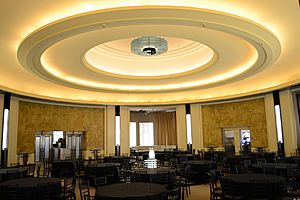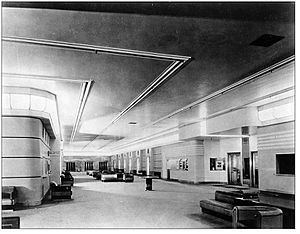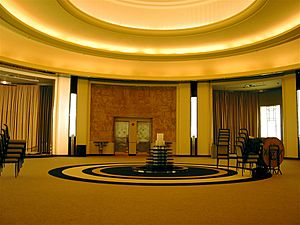The Carlu facts for kids
Quick facts for kids The Carlu |
|
|---|---|

The Round Room
|
|
| Location | Toronto, Ontario, Canada |
| Area | 50,000 sq. ft. |
| Built | 1930 |
| Architect | Jacques Carlu |
| Website | www.thecarlu.com |
| Official name: Eaton's 7th Floor Auditorium and Round Room | |
| Designated | 1983 |
| Official name: T. Eaton Co. College Street Store | |
| Designated | 1975 |
The Carlu is a famous place in Toronto, Ontario, Canada, where special events happen. It first opened in 1930 and was known as "Eaton's Seventh Floor." After being closed for many years, it was fixed up and reopened in 2003. It was renamed "The Carlu" to honor its first architect, Jacques Carlu. This building is a great example of Art Moderne style, which is a cool design popular in the 1930s.
Contents
History of The Carlu
In 1930, a big department store called Eaton's opened a huge new store in Toronto. It was located at Yonge Street and College Street. This store was called "Eaton's College Street."
The Eaton family owned the store. Lady Eaton, a member of the family, was in charge of the store's restaurants. She hired a famous French architect, Jacques Carlu, to design the seventh floor. This floor was going to be very special.
It included a large auditorium with 1300 seats, a unique restaurant called the Round Room, and other fancy areas. A long hallway, designed to look like the inside of an ocean liner, connected all these spaces. From 1931 to 1965, the Eaton Operatic Society performed in the theatre.
Radio Shows and Movies
When the Auditorium first opened, it was used for radio shows, especially during holidays. People could listen to organ music played by famous musicians. The Auditorium also showed movies. Sometimes, an organ player would play music along with the movie, like when "Snow White" was shown in 1931.
Changes and Restoration
In 1977, the Eaton's store at College Street closed. A new Eaton's store opened at the Toronto Eaton Centre. The old store building was sold and renamed College Park.
The new owners wanted to change the seventh floor into offices. But the City of Toronto fought to protect it because it was a special heritage site. In 1986, a court decided that the seventh floor had to be saved. Even though it was protected by law, it was sealed off for 27 years and slowly fell apart.
Finally, in 2001, work began to fix up the seventh floor. It cost a lot of money, but new people came in to help. The restoration was led by architects Scott Weir and Hadi Khouzam.
They made many changes to bring the space back to life. For example, the sloped floors in the auditorium were removed. This made the seating movable again, like it was originally. They also updated the sound system for modern events.
A special fountain by an artist named Lalique, which people thought was lost, was found and put back in the Round Room. The big kitchen was replaced with two smaller ones. This made space for a new entertainment area called the Sky Room. The whole place was renamed "The Carlu" to honor its original designer, Jacques Carlu.
The heating and cooling systems were also updated without harming the old design. In 2008, some of the rooms were redesigned by a TV designer named Sarah Richardson.
Today, The Carlu is a popular place for many events. People hold concerts, dinners, weddings, and fashion shows there. The annual Polaris Music Prize is also presented at The Carlu.
What Makes The Carlu Special?
The Carlu, especially the Eaton's Seventh Floor, was a very important part of Toronto's culture for many years. Famous performers like Billie Holiday, Duke Ellington, and Frank Sinatra played in the Auditorium. The first show by the National Ballet of Canada was also held there. Even the famous pianist Glenn Gould loved the Auditorium's great sound and used it for some of his recordings.

The Round Room, as its name suggests, is a circular room. It has round designs on the ceiling and special areas in the corners. In the middle of the room, there was a beautiful Lalique fountain that glowed from below. Jacques Carlu designed everything in the dining room, from the lights to the dishes and even the waitresses' uniforms. His wife, Natacha, painted murals on the walls showing peaceful country scenes. For many years, the Round Room was one of the fanciest places to eat in Toronto.
Inside The Carlu, a special metal called monel was used for many details. You can see monel in the light fixtures, vents, and doors. It helps to show off the smooth, modern style of the building. Marble panels were also used at both ends of the main hallway. The colors used throughout the floor were inspired by this marble.
Protecting Its History
The entire building at 444 Yonge Street has been protected by the Ontario Heritage Act since 1975. This law helps make sure the building's history is kept safe. The Carlu itself is also listed as a National Historic Site of Canada since 1983. This means it's recognized as a very important place in Canadian history.



